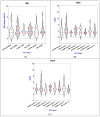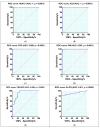Potential Association Between Atherogenic Coefficient, Prognostic Nutritional Index, and Various Obesity Indices in Diabetic Nephropathy
- PMID: 40284203
- PMCID: PMC12030341
- DOI: 10.3390/nu17081339
Potential Association Between Atherogenic Coefficient, Prognostic Nutritional Index, and Various Obesity Indices in Diabetic Nephropathy
Abstract
Background/Objectives: Type 2 diabetes mellitus (T2DM), is a rapidly growing global health concern, often accompanied by chronic kidney disease (CKD) and metabolic disturbances. Obesity-related indices, such as the visceral adiposity index (VAI) and body adiposity index (BAI), have been linked to cardiovascular and renal complications in diabetic patients. However, studies integrating both the atherogenic coefficient (AC) and prognostic nutritional index (PNI) for evaluating diabetic nephropathy (DN) remain limited. This study aimed to assess the associations of obesity-related indices with immunological and nutritional factors in patients with T2DM and prediabetes (PreDM). Methods: A retrospective, cross-sectional study was conducted over six months at a university clinical hospital in Dolj County, Romania. The study enrolled 268 newly diagnosed T2DM patients and 150 PreDM patients. Anthropometric parameters, laboratory tests, and demographic data were collected. AC and PNI were calculated using standard formulas, and statistical analyses were performed to determine their associations with metabolic and inflammatory markers. Results: Our study found that T2DM patients had significantly lower PNI values, indicating mild malnutrition, while PreDM patients maintained a normal nutritional status. AC was significantly higher in T2DM patients, correlating with lipid profile alterations and systemic inflammation. Obesity indices, particularly VAI, were significantly elevated in T2DM patients with higher AC values. Statistically significant differences in total cholesterol, low-density lipoprotein cholesterol (LDL-c), and triglycerides were observed between AC subgroups, reinforcing its role in cardiovascular risk assessment. Conclusions: The findings highlight the potential of AC and PNI as biomarkers for assessing nutritional, inflammatory, and lipemic status in diabetic patients. The significant associations between obesity-related indices, lipid profiles, and inflammation markers suggest that early assessment of these parameters may potentially aid in predicting diabetic complications. Further studies are needed to explore the clinical utility of AC and PNI in managing T2DM and CKD progression. Future research should investigate how the lipidic spectrum alters the progression of DN across various patient groups with diabetes and prediabetes.
Keywords: atherogenic coefficient; chronic kidney disease; diabetic nephropathy; metabolic syndrome; prognostic nutritional index; type 2 diabetes mellitus; visceral adiposity index.
Conflict of interest statement
The authors declare no conflicts of interest.
Figures









References
-
- International Diabetes Federation Diabetes Atlas 10th Edition. 2021. [(accessed on 10 March 2025)]. Available online: https://diabetesatlas.org/resources/idf-diabetes-atlas-2025/
-
- Hu R., Zhao Z., Xie L., Ma Z., Wu W., Li S. Global, regional, and national burden of chronic kidney disease due to diabetes mellitus type 2 from 1990 to 2021, with projections to 2036: A systematic analysis for the Global Burden of Disease Study 2021. Front. Med. 2025;12:1531811. doi: 10.3389/fmed.2025.1531811. - DOI - PMC - PubMed
MeSH terms
Substances
LinkOut - more resources
Full Text Sources
Medical

